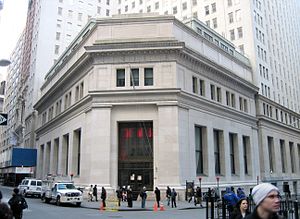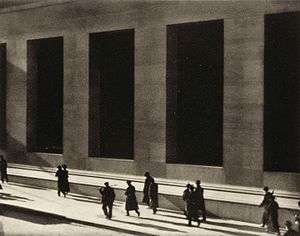23 Wall Street
23 Wall Street or "The Corner", is an office building formerly owned by J.P. Morgan & Co. – later the Morgan Guaranty Trust Company – located at the southeast corner of Wall Street and Broad Street, in Financial District of Manhattan, New York City.
23 Wall Street | |
 (2007) | |

| |
| Location | 23 Wall Street Manhattan, New York City |
|---|---|
| Coordinates | 40.706954°N 74.010644°W |
| Built | 1913[1] |
| Architect | Trowbridge & Livingston |
| Architectural style | Neoclassical |
| NRHP reference No. | 72000874[2] |
| NYCL No. | 0039 |
| Significant dates | |
| Added to NRHP | June 19, 1972 |
| Designated NYCL | December 21, 1965 |
The building was designated a New York City landmark in 1965,[1] and was added to the National Register of Historic Places in 1972. After it was purchased in 2008 by interests associated with the billionaire industrialist Sam Pa, it has been left in a state of disuse.
Description
Designed by Trowbridge & Livingston and built in 1913,[1] the building was so well known as the headquarters of J.P. Morgan & Co. – the "House of Morgan" – that it was deemed unnecessary to mark the exterior with the Morgan name.[3] It replaced the former Second Empire style Drexel Building, which was the banking headquarters for Drexel, Morgan & Co. The building is known for its classical architecture and formerly for its well-appointed interior, including a massive crystal chandelier and English oak paneling, but, overall, is more notable for its history than its architecture.[4]
Even though property prices in the area were very high, the Morgan building was purposely designed to be only four stories tall; the contrast to the surrounding high-rises is reinforced by the astylar exterior, rendered as a single high piano nobile over a low basement, with a mezzanine above, and an attic storey above the main cornice. The plain limestone walls are pierced by unadorned windows in deep reveals. The foundations were constructed deep and strong enough in order to support a forty-story tower should the need arise in the future.
Across Broad Street from this building is the New York Stock Exchange, and across Wall Street is Federal Hall National Memorial. Directly outside are entrances to the Broad Street station (J and Z trains) on the BMT Nassau Street Line of the New York City Subway.
1920 bombing

On September 16, 1920, the building was the site of the Wall Street bombing, in which thirty-eight people were killed and hundreds injured, 143 of them seriously.[5][6] The building received heavy damage, with shrapnel entering the building through its large wide windows. To this day, the damage to the limestone façade is visible on the outside of the building, as the company said it would never repair the damage in defiance to those who committed the crime.
Because the Morgan building was so well known, many assumed that the target of the assumed anarchist bombing was actually the bank itself.
Later history
In 1957, the building was linked to neighboring 15 Broad Street, a 42-story L-shaped tower[7] on a limestone base that echoes 23 Wall Street's facade. In 1989, JP Morgan moved its operations to 60 Wall Street, a larger and more modern building two blocks to the east.[8] 23 Wall Street was extensively renovated in the 1990s as a training and conference facility for J.P. Morgan & Co.[9]
This building and 15 Broad Street were sold in 2003 for $100 million to Africa Israel & Boymelgreen.[7] The two buildings have become a condominium development, Downtown by Philippe Starck, named for French designer Philippe Starck, one of a growing number of residential buildings in the Financial District.[7] Starck made the roof of 23 Wall into a garden and pool, accessible to the residents of the development.[10]
Africa Israel gained full control of 23 Wall Street in 2007;[11] it was sold to a partnership of the China International Fund and Sonangol Group in 2008.[12] The building was unoccupied for years, after the arrest of Sam Pa, believed to be a key leader of the China Investment Fund and the Sonangol Group.[13] Jack Terzi of JTRE Holdings purchased the building in 2016.
In popular culture

- The building is depicted in the famous photograph Wall Street (1915) by Paul Strand.[14]
- 23 Wall Street appears in the 2012 film The Dark Knight Rises, where it represents the exterior of the Gotham City Stock Exchange. The real New York Stock Exchange can be seen in the background of several scenes at this sequence.
References
Notes
- New York City Landmarks Preservation Commission; Dolkart, Andrew S.; Postal, Matthew A. (2009). Postal, Matthew A. (ed.). Guide to New York City Landmarks (4th ed.). New York: John Wiley & Sons. ISBN 978-0-470-28963-1., p.15
- NRHP
- "23 Wall Street", Time Magazine (September 24, 1923); accessed March 15, 2010.
- White, Norval & Willensky, Elliot (2000). AIA Guide to New York City (4th ed.). New York: Three Rivers Press. ISBN 978-0-8129-3107-5., p. 19
- Baily, Thomas A; Kennedy, David M. (1994). The American Pageant (10th ed.). D.C. Heath and Company. ISBN 0-669-33892-3.
- Barron, James. "After 1920 Blast, The Opposite Of 'Never Forget'; No Memorials on Wall St. For Attack That Killed 30" The New York Times (September 17, 2003)
- "Project Updates: 15 Broad Street". LowerManhattan.info. Archived from the original on February 19, 2007. Retrieved January 25, 2007.
- Beasley-Murray, Benjamin; Platt, Gordon (June 1, 2003). "Newsmakers : J.p.morgan Landmark Sold". Global Finance Magazine. Retrieved August 1, 2014.
- Gambee, Robert (1999). Wall Street: Financial Capital. W. W. Norton & Company. pp. 18–20. ISBN 9780393047677.
- Dunlap, David W. (May 11, 2004). "Condos, Not Roll-Tops, on Finance's Holiest Corner". The New York Times. Retrieved January 25, 2007.
- Koblin, John (August 2, 2007). "Leviev and Boymelgreen: The Thrill Is Officially Gone". The New York Observer. Archived from the original on December 9, 2009. Retrieved October 17, 2011.
- Murray, Laura Rena; Morrissey, Beth; Ojha, Himanshu; Martin-Menard, Patrick (October 17, 2011). "African Safari: CIF's Grab for Oil and Minerals". Caixin. Retrieved October 17, 2011.
- Cuozzo, Steve. (December 27, 2015) "The Wall Street Landmark Left to Rot". New York Post Accessed December 27, 2015.
- Robert Silberman, "Paul Strand Retrospective. Saint Louis Art Museum," The Burlington Magazine 133, no. 1061 (August 1991): 571-572.
External links
| Wikimedia Commons has media related to 23 Wall Street. |

